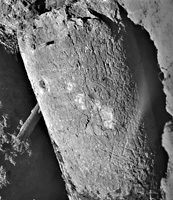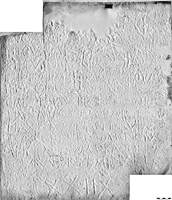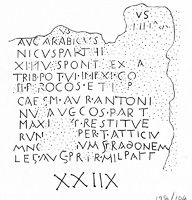 MAMA XI 9 (Apollonia)
MAMA XI 9 (Apollonia) 
Milestone of T. Atticius Norbanus Strabo
- Type of monument:
- Milestone.
- Location:
- Gençali (Apollonia): in a field 1.5km north of the village and 100m from the shore of Eğirdir Gölü.
- Description:
- Limestone milestone, broken below, chipped at top.
- Dimensions:
- Ht. 1.40+; Diameter 0.58 (top); letters 0.030-0.040.
- Record:
- Squeeze; line drawing; MB notebook copy; photograph (1956/104).
- Publication:
- Pace 1921: 51, no. 39 (AE 1922, 5; mentioned by Ballance 1958: 232, n.16; French 1976: 53; French 1988: 150, no. 394).
- Date:
- AD 198.
[Imp(erator) Caes(ar) L(ucius) Septimi]us
[Sever]ụṣ [Pius Per]ṭịṇạx̣
Aug(ustus) Arabicus Ạ[diabe]-
nicus Parthị[cus ma]-
5ximus ponṭ[ifex max(imus)]
trib(unicia) pot(estate) VI imp(erator) [XI co(n)s(ul)]
II proco(n)s(ul) et [Imp(erator)]
Caes(ar) M(arcus) Aur(elius) Antoni-
nuṣ Aug(ustus) 〚co(n)s(ul) Part[hi]cu[s]〛
10〚maxi[m]us〛 restitue-
run[t per] {per} ⟨C⟩(aium) Atticiu-
m No[rba]ṇum ⟨St⟩ra⟨b⟩onem
leg(atum) Aug(usti) pr(o) pr(aetore) mil(ia) pass(uum)
XXIIX
Lines 1-2: IMP · CAES · SEPT · | SEVER[.]S Pace;
Line 6: TRIB · POT · VIII[- -] Pace;
Line 7: P · P · PROCOS Pace;
Line 11: RUNT PER · PE[-]T · ATTICIU Pace. (On the praenomen, see commentary below);
Line 12: G̣RAOONEM lapis.
Imperator Caesar L. Septimius Severus Pius Pertinax Augustus, Arabicus, Adiabenicus, Parthicus maximus, pontifex maximus, holding the tribunician power for the sixth time, imperator for the eleventh time, consul for the second time, proconsul, and Imperator Caesar M. Aurelius Antoninus Augustus, 〚consul, Parthicus maximus,〛 restored (the road) through the offices of ⟨C⟩. Atticius Norbanus Strabo, legatus Augusti pro praetore. 28 miles.






Between 1914, when this milestone was seen and copied by B. Pace (‘poco lungi da villagio sulla via in una piccola vigna Osmanoğlu Osman’), and 1956, when it was recorded by Ballance, the stone had suffered damage to lines 1-2, for which we remain dependent on Pace’s readings. Pace was also able to read the whole of line 11, part of which had been obliterated by 1956. The milestone was seen again by French in 1974 (French 1976: 53), at which point it was serving as the west jamb of the gate into the mosque garden at Gençali.
Seven other milestones are known from the vicinity of Gençali:
(a) Waldmann 1981: 99-100, no. 7 (French 1988: 151, no. 395; revised by Christol and Drew-Bear 1986: 51-3), Augustus, 6 BC, distance XXIII.
(b) CIL III 6965-7 (French 1988: 150, no. 393), three texts, of which two (6967 and 6965) carry distance numerals: (a) CIL III 6967, Hadrian, AD 127/8, distance XXIX; (b) CIL III 6965, Constantine I, AD 317 (for the date, Christol and Drew-Bear 1986: 43-51), distance Apollonia MP XVIII.
(c) Waldmann 1981: 100, no. 8 (French 1988: 151-2, no. 396; revised by Christol and Drew-Bear 1986: 46-7, esp. 47 n.30), Constantine I, AD 317, distance unknown.
(d) French 1988: 152, no. 397 (unpublished), Constantinus with 〚Constantinus〛, Constantius, and Constans, distances XXIIX and Mi ΙΘ (19 miles).
(e) French 1988: 152-3, no. 398 (unpublished), Septimius Severus and colleagues, governor Atticius Strabo, AD 198, distance XXVII.
(f) French 1988: 153, no. 399 (unpublished), Philippus, distance unknown.
(g) French 1988: 153, no. 400 (unpublished), Constantinian, distance unknown.
Of particular interest here is (e), another milestone of Atticius Strabo, with the distance numeral XXVII, said by French to have been discovered in situ c. 2.9km east [i.e. north-east] of the Gençali village cemetery. The location and distance-numeral are precisely compatible with our milestone, which carries the distance numeral XXIIX and was discovered 1.5km north of Gençali. The caput viae ought therefore to lie some 28 or 29 Roman miles north-east of Gençali, no doubt at Antiocheia by Pisidia. Milestones nos. (b) and (d) both indicate the distance to the nearest towns to both east and west: milestone no. (b) gives 29 miles [sc. from Antiocheia] and ‘Apollonia 18 miles’, while milestone no. (d) gives 28 miles [sc. from Antiocheia] and 19 miles [sc. from Apollonia].
The year AD 198 saw a large-scale restoration of the military roads across the Asia Minor peninsula (Christol and Drew-Bear 1992: 343). Fourteen milestones of Atticius Strabo (PIR2 A 1331) dating to this year are known from the province of Galatia. These milestones fall into three clearly defined geographical clusters, in the vicinity of the ancient cities of Tavium, Apollonia, and Ikonion.
Group 1: Region of Tavium
(1) Strobel 2003: 165-6, no. A2 (AE 2003, 1709): Küçüknefes, south of Tavium, distance 3 MP (from Tavium).
(2) Strobel 2003: 173-4, no. B3 (CIL III 6899a; CIL III 14184/41 [sic; 14184/14 Strobel and AE, per lapsum]; French 1981: 168-9; French 1988: 355, no. 974; AE 2003, 1715): Dambasan, north of Tavium, on the road towards Amaseia, distance 5 MP (from Tavium).
(3) Unpublished (French 1988: 356, no. 977): Haydarbeyli, north of Tavium, on the road towards Amaseia, distance not preserved.
(4) Bittel 1985: 11-12 (AE 1985, 809; French 1988: 134, no. 353): Yazır, north of Tavium, on the road towards Amaseia, distance 12 MP (from Tavium).
(5) Bittel 1985: 13-14 (AE 1985, 810; French 1988: 130-1, no. 343): Karakeçili, north of Tavium, on the road towards Amaseia, distance 13 MP (from Tavium).
(6) Bittel 1985: 15-16 (AE 1985, 812; French 1988: 135, no. 355; Strobel 2003: 166; AE 2003, 1710): Yekbaş, north of Tavium, on the road towards Amaseia, distance 20 MP (from Tavium).
Group 2: Region of Apollonia
(7) French 1981: 167-70, no. 13 (French 1988: 18, no. 43; AE 1986, 683; AE 1992, 1643b): Kocasancar Mevkii, c. 10km WNW of Apollonia, distance 8 MP (from Apollonia: see further below).
(8) MAMA XI 9 (1956/104: this text): north of Gençali, on the road from Antiocheia by Pisidia towards Apollonia, distance 28 MP (from Antiocheia: see above).
(9) = (e) above. Unpublished (French 1988: 152-3, no. 398): east of Gençali, on the road from Antiocheia by Pisidia towards Apollonia, distance 27 MP (from Antiocheia: see above).
Group 3: Region of Ikonion
(10) French 1988: 214, no. 594 (Ramsay 1905: 415-6, no. 7; AE 1906, 21; Callander 1906: 172, no. 56; Ballance 1958: 230, no. 14): Akbaşyayla, Kutudelik Han, on the road running NE from Ikonion, distance not preserved.
(11) MAMA XI 295 (1957/41: Ballance 1958: 230, no. 13; French 1988: 220, no. 612): Divanlar, on the road running NE from Ikonion, no distance numeral.
(12) Unpublished (seen by W. M. Calder in 1908; mentioned by Ballance 1958: 230, no. 17; French 1988: 235, no. 658): Obruk, on the road running NE from Ikonion, no distance numeral; attribution to T. Atticius Strabo uncertain.
(13) A. M. Ramsay 1910: 22-4, no. 6 (Ballance 1958: 230, nos. 16 and 31; French 1988: 232, no. 648): Kulakmurat Han, on the road running N from Ikonion, distance not preserved.
(14) French 1988: 215-6, no. 598 (Callander 1906: 173, no. 58; AE 1907, 58; Ballance 1958: 230, no. 15): Zıvarık (now Altınekin), probably on the road running N from Ikonion towards Ankara, distance 105 MP. The caput viae is uncertain: see MAMA I p.193, n.1; Ballance 1958: 232.
Each one of these fourteen milestones originally carried the full titulature of Caracalla and Geta: ...et Imp. Caes. M. Aur. Antoninus Aug. et P. Septimius Geta nob. Caes. restituerunt (with minor variations). After the damnatio memoriae of Geta in 211, the text of most of these milestones was altered so as to remove the reference to Geta. In most instances, Geta’s name was replaced with two further titles for Caracalla, Imp. Caes. M. Aur. Antoninus Aug. 〚cos. Parthicus maximus〛 restituerunt; the first of these titles is anachronistic, since Caracalla’s first consulate did not fall until 202, and Caracalla seldom carried the title Parthicus maximus before 211 (Mastino 1981: 50-1; cf. 76-8). This anachronistic addition is the cause of some confusion in Bittel 1985: 11-16, AE 1985, 809, and Ameling 1995: 696.
It seems not previously to have been noted that the three groups of milestones all give slightly different versions of Atticius Strabo’s name. The five published milestones from the vicinity of Tavium (nos. 1-2, 4-6) all give the gentilician and cognomen alone (per Atticium Strabonem); his second gentilician, Norbanus, is given only by the two published milestones from the vicinity of Apollonia (nos. 7 and 8). The praenomen is preserved only on our milestone (no. 8), and on two milestones from the vicinity of Ikonion (nos. 13 and 14). On both the milestones from the vicinity of Ikonion, the praenomen is clearly stated to be Gaius (no. 14, per C. Atticium Strabonem; no. 13, [p]er Gaium Att[icium] Strabonem); on our milestone from Gençali (no. 8), the reading T(itum) is certain. Given the consensus of the Ikonian milestones, and the presence of mason’s errors elsewhere in the governor’s name on the Gençali milestone (line 12, G̣RAOONEM for ⟨St⟩ra⟨b⟩onem), it seems most likely that T(itum) on the Gençali milestone is a mason’s error for C(aium). I have corrected the text accordingly.
The new readings of the Gençali milestone help us to improve the text of no. (7) above, a near-identical milestone situated further to the west on the same road. Milestone (7) was discovered at a site (Kocasancar Mevkii) in the plain of İlek (the ancient village of Plinnenoi), c. 10km WNW of Apollonia, on the road between Apollonia and Apameia: on the geography, see Christol and Drew-Bear 1987: 18-19. The stone was first seen by Ramsay in 1905 (Ramsay 1906: 234; Ramsay 1926: 105), and was published by French 1981: 167-70, no. 13 (AE 1986, 683). Two photographs of the milestone were published by Christol and Drew-Bear 1987: Pl. V-VI. At the beginning of line 15, French omitted four mysterious letters CλΓΓ, noted by Christol and Drew-Bear 1987: 19, and illustrated and discussed by Christol and Drew-Bear 1992: 345-7, with Fig. 2 (AE 1992, 1643b). With this addition, the text established by French reads as follows:
[Imp · Cae]s · L · Sept[imius · Sev|erus ·] P̣ius · Perti[nax | Aug ·] Ạrab Adiab[eni|cu]s · P̣arthicus [· max |(5) pon]tifex max [· tr ·| pot ·] VI · imp · XI cos | [pro]cos et Imp Cae[s | M · Aur ·] Antoninus Au⟨g⟩ | [( vac. ?)] 〚Part · max〛 ( vac. ) |(10) [viam] restituerunt | [per · T ·] Ạtticium [· N]|orbanum Stra|bonem leg | Aug pr pr mil |(15) CλΓΓ VIII
As on most other milestones of this type, the title 〚Part(hicus) · max(imus)〛 in line 7 is inscribed over a rasura, which originally carried the words et · P · Septimius · Geta. On the parallel of line 9 of the Gençali stone, we ought certainly also to restore [〚cos〛] at the start of the line, where both French and Christol and Drew-Bear assume a vacat. In line 14, Christol and Drew-Bear 1987: 19 claim that ‘la lecture AVGG est évidente (et non AVG)’; however, as already noted by Thomasson 1983: 134, the singular AVG is found on several other milestones of Atticius Strabo, including the Gençali milestone, and hence there is no need to correct it here. As we have seen above, on the authority of the Ikonian milestones of Atticius Strabo, line 11 should certainly be restored [per · C ·] Ạtticium.
At the start of the final line of the Kocasancar milestone, Christol and Drew-Bear read the four mysterious letters CλΓΓ (not copied by French), which they interpreted as representing Σαγαλασσέων (Christol and Drew-Bear 1992: 345-7, with Fig. 2; cautiously accepted by Mitchell 1999b: 32 n.70). They further argued that these four letters were added (in the Greek alphabet) in the tetrarchic period, when Sagalassos and Apollonia both formed part of the new Late Roman province of Pisidia. However, on the parallel of lines 13-14 of the Gençali milestone (leg. Aug. pr. pr. mil. pass. XXIIX), we might prefer to assume that the sequence CλΓΓ is simply the mason’s attempt to represent the letters PASS, i.e. the Latin word pass(uum).